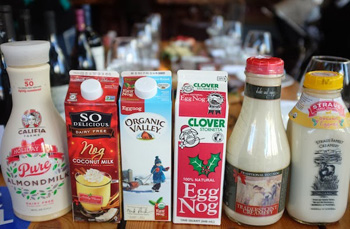
When the holidays roll around, I'm always tempted, but often disappointed by the eggnog available at the supermarket. This year I was sent a sample of eggnog from Organic Valley and was surprised by how good it was. It wasn't fluffy, but it was rich and creamy and it didn't have any strange flavors or weird texture. I wanted to see if other eggnogs were equally as good.
Thanks to a connection at Whole Foods, the next thing I knew a handful of local food writers and bloggers were sitting around a table tasting eggnogs and also some desserts, cheeses (Uniekaas truffled gouda, oh la la!) a delectable baked spiral sliced Wellshireham and wine for good measure (more about that later).
Here are the results:

 There are some cookies that are destined to become a holiday tradition. In my family's case, the traditional cookies were those that had become favorites -- my dad loved the thumbprints that his mom made each year and then they became my favorite. My brother loved the Chocolate Shot Cookies.
There are some cookies that are destined to become a holiday tradition. In my family's case, the traditional cookies were those that had become favorites -- my dad loved the thumbprints that his mom made each year and then they became my favorite. My brother loved the Chocolate Shot Cookies. Europeans do it better. Not the wine, beer, and cheese, which are all great, but the holidays and vacations. A holiday in Europe occupies at least two
weeks. Summer vacation is six to eight. With that much time off from
work, one’s internal clock resets. The mind and body slow down to take
in the pleasures of the moment.
Europeans do it better. Not the wine, beer, and cheese, which are all great, but the holidays and vacations. A holiday in Europe occupies at least two
weeks. Summer vacation is six to eight. With that much time off from
work, one’s internal clock resets. The mind and body slow down to take
in the pleasures of the moment.

 Americans in particular love a good chocolate chip cookie. That's in large part do to
Americans in particular love a good chocolate chip cookie. That's in large part do to 